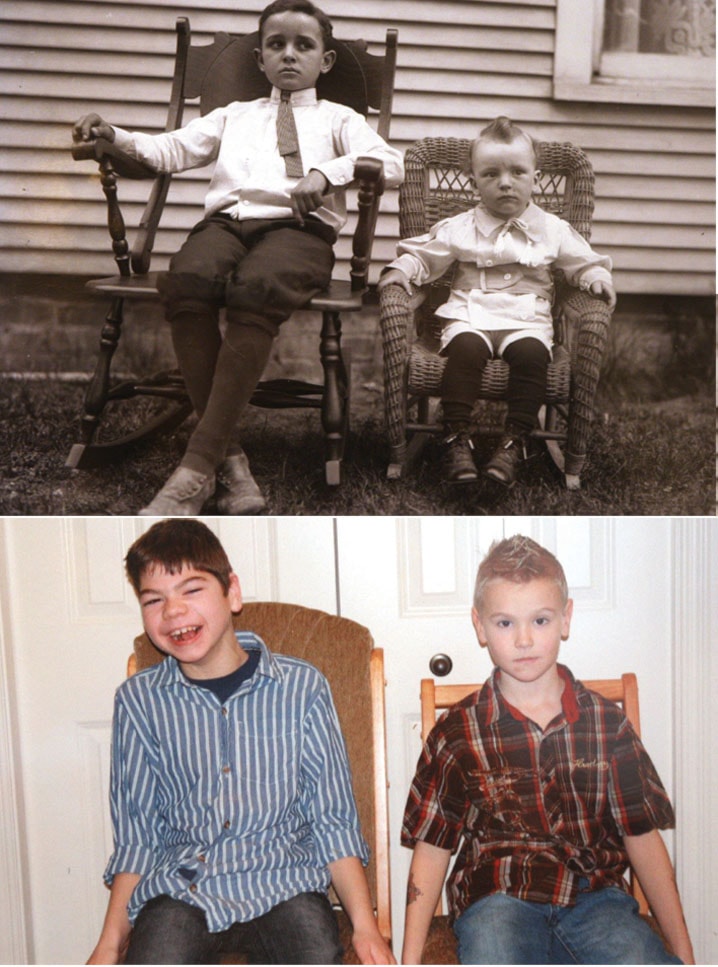The five children are lined up shortest to tallest in each of the two photographs — and a family dog is positioned on the right side of both frames.
In a black-and-white photo from 1913 pulled from the Red Deer Archives, the cherubic Spiers children, looking stiff but happy in formal clothing, each have a hand on their taller sibling’s shoulder.
In the corresponding 2013 photograph of the Dueck children, composed by Grandview School student Lauren Dueck, there’s no physical connection between the casually dressed kids.
In fact, they appear to be ignoring each other and looking down at their own handheld electronic device.
One hundred years separates the Spiers children from the Duecks, and what change has a century wrought!
Through Our Eyes, an inventive photographic exhibition that celebrates the city’s centennial at the Red Deer Museum and Art Gallery shows the huge societal, industrial, technological, cultural and lifestyle differences that have resulted in the last 100 years.
But the century-spanning photographs also show us that as much as some things have changed, they have also stayed the same.
The idea for the exhibit originated with staff at the city archives who wanted to involve some Red Deer youngsters in a hands-on centennial project. School names were drawn out of a bowl and Grandview Elementary School students in Susan Mueller’s Grade 5 class got to participate in what was surely a very memorable history lesson. (Project participants also include Mayor Morris Flewwelling and some archives staff members.)
The Grade 5 students were asked to select an archival photograph that interested or inspired them, then create their own corresponding modern photo. There were no further parameters, said associate archivist Brianne Stone. “They were given free rein to recreate them however they wanted.”
Many of the youngsters, who learned about the history of photography, went to the same vantage points an old photograph was taken from and recorded the way historic structures and street-scapes appear now.
Pedestrians with long skirts and derby hats on Ross Street or Gaetz Avenue were replaced by modern subjects wearing ski jackets. Horse buggies and Model T Fords evolved into current parked vehicles.
Sometimes the recorded changes were immense, such as the view of Red Deer hospital from Piper Hill. The original hospital building has grown tenfold since 1913, and hotels, a doughnut shop and bus station have sprung up where the sprawling Piper Brick Co. yard once stood.
Stone’s favourite photo is one taken by Sydney Woodford, of the CP Rail bridge, which is now converted for cyclists and pedestrians. Instead of the wooden powerhouse that used to stand next to the bridge, Woodford has captured green graffiti spray painted onto a concrete bridge support. It’s that “green splash of paint,” that caught Stone’s eye.
Fellow associate archivist Selena Percy likes the night shot of Flewwelling, artistically captured in front of the old armories building (now part of the Red Deer Public Library) by his son.
Some of the most interesting photographs are of people and record lifestyle changes. For instance, Tyra Lloyd arranged a photo to be taken of herself and her dog Pip, which was inspired by an archival photo of Mrs. Page and her dog Kipps.
Both of the subjects are sitting on wooden stairs in front of a house. But whereas Mrs. Page had only an umbrella in her lap, Lloyd is holding an iPad and sitting next to a rain barrel and solar-powered garden light.
Brothers Relaxing, is a photo of Tye Heintz and his younger brother, which corresponds with an archival photo of two seated boys, taken by J.H. Gano.
Both youngest boys share the same pensive expression in both pictures. But Heintz is laughing, unlike the stern older brother photographed in 1912. The Grandview student pointed out that smiling in photos is now easier, thanks to the quicker shutter speed. “Years ago, they had to sit there for a long time.”
Christmas Time, a photo by student Zach Danchek, shows the excesses of modern Christmas celebrations, compared to the meagre offerings evident in a 1912 picture taken by Gano of a tiny child standing beside an equally diminutive tree.
The Christmas tree in the historic photo is decorated only with a pair of woolen mitts, a small bell, some greeting cards, a wisp of garland and, curiously, a figure of a cyclist, instead of a treetop angel.
Danchek acknowledged “a lot of things have changed” — including the modern trend of expanding Christmas decorating throughout the house.
Percy hopes the Through Our Eyes exhibit will encourage more people to reflect on the city’s evolution, and to check out the treasures in the Red Deer archives. Among them are some diary entries from as early as 1850, as well as “hundred of thousands of photographs.”
The exhibit is on until June 23.
lmichelin@www.reddeeradvocate.com
